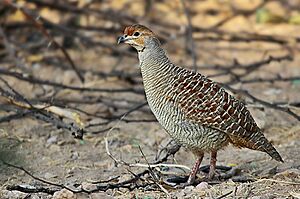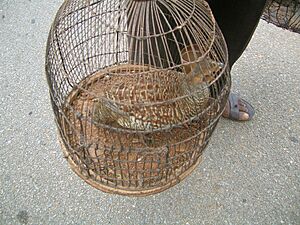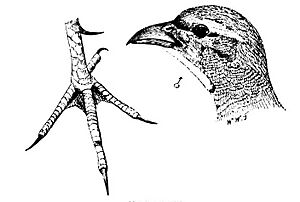Grey francolin facts for kids
Quick facts for kids Grey francolin |
|
|---|---|
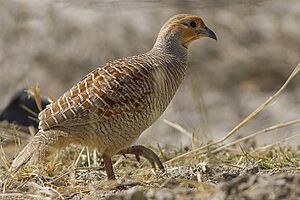 |
|
| At the salt pan of Tal Chappar, Rajasthan, India |
|
| Conservation status | |
| Scientific classification | |
| Genus: |
Ortygornis
|
| Species: |
pondicerianus
|
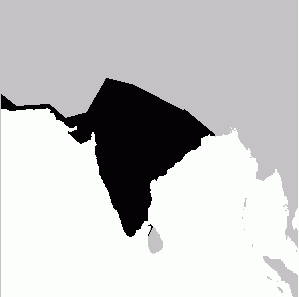 |
|
| Synonyms | |
|
Francolinus ponticerianus |
|
The grey francolin (Ortygornis pondicerianus) is a type of bird found in the dry, flat areas of the Indian subcontinent and Iran. People sometimes call it the grey partridge, but it's different from the European grey partridge. These birds mostly live on the ground. You can find them in open fields and bushy forests. Their local name, teetar, comes from their loud, repeated calls. It sounds like Ka-tee-tar...tee-tar. This call can be made by one or more birds. The word teetar can also mean other similar birds like partridges and quails.
Contents
About the Grey Francolin
The grey francolin is a medium-sized bird. Males are usually about 29 to 34 centimeters (11.6 to 13.4 inches) long. Females are a bit smaller, around 26 to 30 centimeters (10.2 to 11.9 inches) long. Males weigh about 255 to 340 grams (9 to 12 ounces). Females weigh 198 to 312 grams (7 to 11 ounces).
What Does It Look Like?
This bird has stripes all over its body. Its face is light-colored with a thin black line around its pale throat. The only bird that looks similar is the painted francolin. However, the painted francolin has a reddish-brown area under its tail. Male grey francolins can have one or two sharp points, called spurs, on their legs. Females usually do not have these spurs.
There are slight differences in how grey francolins look depending on where they live:
- Birds in dry areas like North-Western India, Eastern Pakistan, and Southern Iran are the palest.
- Birds in northern India are a bit darker.
- Birds in southern India and Sri Lanka have a darker reddish-brown throat and eyebrow stripe. They are also a richer brown color.
Grey francolins are not strong fliers. They fly short distances and then quickly hide in bushes. When they fly, you can see their chestnut-colored tail and dark wing feathers.
Where Do They Live?
Grey francolins usually look for food on bare ground or in areas with low grass. They live in bushy areas and open countryside. In India, they are rarely found higher than 500 meters (1,640 feet) above sea level. In Pakistan, they can be found up to 1,200 meters (3,900 feet) high. Their home range stretches from the foothills of the Himalayas, west to the Indus valley, and east to Bengal. They also live in north-western Sri Lanka. Some grey francolins have been brought to the Andaman Islands and Chagos Islands. They have also been introduced to Nevada in the United States and Hawaii.
Behaviour and Life Cycle
Calls and Groups
You can often hear the loud calls of grey francolins early in the morning. Sometimes, a pair of birds will call together in a duet. The female's call sounds like tee...tee...tee or kila..kila..kila. The challenge call, which is a duet, sounds like kateela..kateela..kateela. These birds are usually seen in small groups.
Reproduction
The main time for grey francolins to breed is from April to September. They make their nests in a hidden spot on the ground. Sometimes, a nest might even be found above ground, in a small space in a wall or rock. A female usually lays six to eight eggs. However, sometimes more eggs are found in a nest. This might happen if another female bird lays her eggs in the same nest.
What Do They Eat?
Grey francolins eat seeds and grains. They also eat insects, especially termites and beetles. Sometimes, they might even catch larger prey like small snakes.
Roosting and Health
These birds sleep in groups in low, thorny trees. Like many animals, grey francolins can have different types of tiny parasites.
Grey Francolins and People
Hunting and Trapping
People hunt grey francolins in many parts of their range. They are often caught using low nets. Hunters sometimes use decoy birds, which are captive birds that call out to attract wild ones.
In Culture
Grey francolins have been kept as pets and used for traditional bird contests in northern parts of the Indian subcontinent for a long time. These domesticated birds can grow quite large, weighing around 500-600 grams (about 1 pound), much heavier than wild birds which weigh about 250 grams. People who raise them often do so by hand. This makes the birds very tame, almost like a pet dog.
Many writers have described how gracefully these birds run. Allan Octavian Hume, a famous bird expert, once said that they "seem to glide rather than run." He also noted that calling a woman's walk like a partridge's run was a high compliment.
John Lockwood Kipling, the father of the famous writer Rudyard Kipling, also wrote about partridges. He said that the bird follows its owner with a quick and pretty walk. He mentioned that in Indian poetry, saying a sweetheart runs like a partridge is a common and beautiful comparison.



